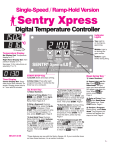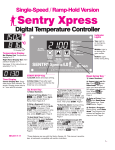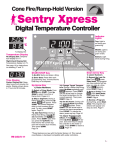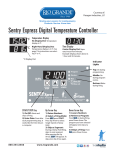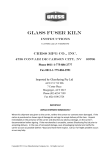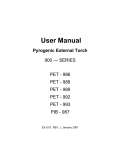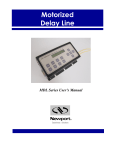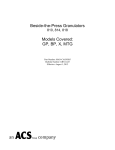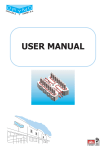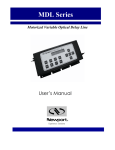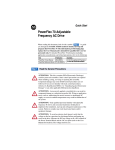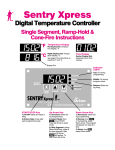Download Rio Grande RG-70 Instruction Manual
Transcript
Rio Grande RG-720 Instruction Manual °F °C Temperature Display Temperature display is in °F. Time Display Temperature display is in °C. See page 7 for instructions on selecting °F and °C. : Separates hours from minutes. Example: Display shown above is 1 hour and 2 minutes. °C Display Dot Indicator Lights On during programming. Program Review Hr./Min. when lit On during program review. Run °F When Off °C When Lit START/ STOP HIGHER Blinks dur- LOWER SENTRYXpress MICRO ing firing. PROCESSOR TM The Sentry Xpress 2.0 micro processor is manufactured by the Orton Ceramic Foundation and displays the CE mark. START/STOP Key firing. Starts and stops a Press after each programming step. It works like the Enter key on a computer. Up Arrow Key Down Arrow Key From press START. Press Up Arrow to select a program. from or during firing, press Down Arrow. The program you have selected will appear one step at a time. during a User Defined firing, skips to the next segment. After pressing Up Arrow, will appear. To skip, press Up Arrow. again. from Arrow. press Down 1 Contents General Guidelines . . . . . . . . . . . . . . . . . 3 Time and Temperature Display . . . . . . . . . . . . . . . . . . . 3 Operation Begins from the IdLE Display . . . . . . . . . . . . . . . . . . . . . . . . . . . . . . . . . . 3 Thermocouple Inspection . . . . . . . . . . . . . . . . . . . . . . . 3 A Rapid Way to Scroll Numbers . . . . . . . . . . . . . . . . . . 3 Program Review & Repeat Firing . . . . . . . . . . . . . . . . . 3 Delay . . . . . . . . . . . . . . . . . . . . . . . . . . . . . . . . . . . . . . . 3 Rate . . . . . . . . . . . . . . . . . . . . . . . . . . . . . . . . . . . . . . . . 4 Power Failures . . . . . . . . . . . . . . . . . . . . . . . . . . . . . . . . 4 CPLT Message: Firing Completed . . . . . . . . . . . . . . . . 4 Thunder Storms and Power Surges . . . . . . . . . . . . . . . 4 Theory of Operation . . . . . . . . . . . . . . . . 4 Hold . . . . . . . . . . . . . . . . . . . . . . . . . . . . . . . . . . . . . . . . 5 Two Firing Modes: Single Segment and Ramp-Hold . . 5 Single Segment Programming Instructions . . . . . . . . . 5 Temperature Over-Shoot . . . . . . . . . . . . . . . . . . . . . . . . 6 Ramp-Hold Mode. . . . . . . . . . . . . . . . . . . 6 Repeat Firings . . . . . . . . . . . . . . . . . . . . . . . . . . . . . . . . 6 Programming a Cooling Segment. . . . . . . . . . . . . . . . . 6 A Ramp-Hold Practice Program . . . . . . . . . . . . . . . . . . 7 Skipping a Segment in a Ramp-Hold Program . . . . . . 7 Ramp-Hold Programming Instructions. . . . . . . . . . . . . 7 Safety The warranty on your Sentry Xpress controller does not cover damage from overfiring, regardless of the circumstances. It is the operator’s responsibility to make sure the kiln turns off at the proper time. When the kiln is not in use, disconnect the power. Do not leave the kiln unattended, especially near the expected shut-off time. Wear firing safety glasses when looking into the firing chamber of a hot kiln. Do not touch hot sides of kiln. Keep unsupervised children away. Install your kiln at least 12 inches from any wall or combustible surface. Do not open lid or door until kiln has cooled and all switches are off. Lost Wax Burnout . . . . . . . . . . . . . . . . . . 8 Fire only in a well-ventilated, covered and protected area away from combustible materials. Overview. . . . . . . . . . . . . . . . . . . . . . . . . . . . . . . . . . . . . 8 A Sample Program. . . . . . . . . . . . . . . . . . . . . . . . . . . . . 8 Burnout Instructions. . . . . . . . . . . . . . . . . . . . . . . . . . . . 8 Keep cordset away from hot sides of kiln or furnace. Error Messages . . . . . . . . . . . . . . . . . . . . 9 BAdP / Bad Programming . . . . . . . . . . . . . . . . . . . . . . . 9 EtH / Electronics Too Hot . . . . . . . . . . . . . . . . . . . . . . . 9 FaIL / Thermocouple Failure . . . . . . . . . . . . . . . . . . . . . 9 TCR / Thermocouple Reversed . . . . . . . . . . . . . . . . . . . 9 FtL / Fired Too Long . . . . . . . . . . . . . . . . . . . . . . . . . . . 9 PF 1 / Power Failure. . . . . . . . . . . . . . . . . . . . . . . . . . . . 9 PF 2 / Power Failure. . . . . . . . . . . . . . . . . . . . . . . . . . . . 9 TcO / Thermocouple Failure . . . . . . . . . . . . . . . . . . . . . 9 Selecting °F or °C Display . . . . . . . . . . . . 9 Display Messages . . . . . . . . . . . . . . . . . 10 Trouble Shooter. . . . . . . . . . . . . . . . . . . 10 Problem: Controller display is blank. No heat in kiln.. 10 Problem: Controller display turns on. No heat in kiln. 11 Problem: Kiln switch box ½ amp fuses keep blowing. 11 ©2004, by Paragon Industries, L.P. IM-221/10-04 2 Single Segment/Ramp-Hold DANGEROUS VOLTAGE! Do not touch heating elements with anything. Disconnect before servicing. General Guidelines I A Rapid Way to Scroll Numbers The and keys change number settings during programming. Ordinarily, you would press to raise a number and to lower it. But sometimes it is faster to press the opposite key. This is because the numbers scroll below 0000 to the highest number, and vice versa. Examples: Time and Temperature Display Center Dot: Time A center dot appears during time display. It separates hours from minutes (i.e. 1 hour, 30 minutes displays as 01.30). During temperature display, the dot disappears. The center display dot indicates time instead of temperature. °F Right-Hand Dot: °C When temperature is displayed in °C, a dot appears in the lower right. In °F display, it disappears. You can choose between Fahrenheit and Celsius display. See page 9. °C I To program a 99.59 hour Hold when the display shows 00.00, press the once. I To program a FULL rate when the display shows 0000, press the once. I To program a temperature of 200°F when the display shows 1800°F, press the . That is faster than pressing the . Program Review & Repeat Firing Program Review lets you check that the information programmed into the controller is correct. It is a good habit to use Program Review before every firing. Program Review shows the values for the program in active memory, which is— Operation Begins from the IdLE Display The program that was fired last. must appear before you can fire the kiln. I If , , or other message appears instead of when the kiln is first turned on, press the key (the key with the circular arrow). will appear. I If you press pear. To get back to I If the display shows an error message such as stead of , see page 9. I (firing completed) appears at the end of a firing. To make appear, press . during a firing, , press Keep shelves, posts and ware 1” - 1 ½” away from the thermocouple. will apagain. in- Thermocouple Inspection The small rod protruding into the firing chamber is the temperature sensor, or thermocouple. CAUTION: Bumping the thermocouple can push it out of the firing chamber. This could cause an overfire! The controller does not contain an alarm to detect this type of failure. Bumping the thermocouple could also cause inaccurate readings. The program that was selected since the last firing. I press the key. The rate, temperature, hold, etc. will display one after the other. Firing will continue. I press the key. After rate, temperature, hold, etc., will appear. Press . will appear, and the kiln will begin firing the program just reviewed. Delay Delay is a count-down timer. The kiln begins firing when the timer runs out of time. Use Delay to fit a firing into your schedule. CAUTION: For safety, do not leave the kiln alone during a delay or a firing. We cannot guarantee your kiln against overfiring even though the controller is automatic. After you have selected a program and the controller is ready to begin firing, will appear. I A 1/8” diameter thermocouple should extend into the firing chamber ½” - 5/8”. Press the alternating with key once. . will appear, I A ¼” diameter thermocouple should extend into the firing chamber 1” or more. Use the arrow keys to enter delay time. (The decimal separates hours and minutes. Example: 1 hour 10 minutes = 01.10) Then press . will ap- 3 pear, alternating with time left until the firing begins. Power Failures After a power failure, the controller will continue firing provided that: I The kiln temperature is above 212°F/100°C when the power comes back on. I The temperature dropped no more than 180°F/100°C while the power was off. 1) It fires at a controlled heating rate, or speed, measured in degrees of temperature change per hour. 2) It fires to a target temperature. 3) It can hold the target temperature. Power Failure Messages The power failed during firing, and temperature dropped more than 180°F/100°C. The power failed during firing, and kiln temperature was below 212°F/100°C when the power came back on. CPLT Message: Firing Completed When the firing has successfully completed, the Sentry Xpress will shut off power to the elements. Then three messages will cycle one after the other: (complete) Firing time in hours and minutes The current kiln temperature Thunder Storms and Power Surges Unplug the kiln or disconnect the power when the kiln is not in use, especially during thunder storms and in areas with frequent power surges. If the kiln is part way through a firing when a storm begins, it is probably okay to continue the firing with close supervision. Do not leave the kiln unattended. Theory of Operation The temperature you are firing to is called the target temperature. After the controller reaches the target temperature, it can also hold that temperature. The controller fires at a controlled heating rate. The rate is figured in degrees per hour. If you selected a rate of 100° per hour, it would take 10 hours for the kiln to reach 1000°. Rate is similar to “miles per hour.” In summary, the controller does three basic tasks: 4 Single Segment/Ramp-Hold The controller fires in segments, or stages. A segment is a given heating rate to a target temperature. Shown in the left column is a segment with a target temperature of 1250° and a rate of 625°, with a hold of one hour. Heating rate is figured in degrees per hour. The recommended heating rate for the material you are firing is usually available from your supplier. It also varies depending on the thickness of the material. To figure how long a firing segment will take, subtract the current temperature from the target temperature and divide the resultant temperature by the heating rate. In the diagram above, the firing time is 1250° - 80° (room temperature) = 1170 ÷625 = 1.87 hours. The controller can fire up to 8 segments per firing. One segment is often all that is needed, though. After the controller has finished firing the last segment, it will turn off power to the elements. Rate Each segment must include a rate, which is degrees of temperature change per hour. The kiln will fire at full power when the rate is 1799°F/999°C. Full power displays as . Note: To enter full power from key once. , press the Hold Hold maintains a steady temperature for the length of time you specify. You can use Hold in both heating up and cooling down segments. Single Segment Programming Instructions Note: Single Segment firing is all you will ever need if you are only going to a temperature and holding. When Hold is set to 99.59 hours, the controller will remain at that temperature indefinitely, until you press . To enter a 99.59 hour Hold, press the once from 00.00 during programming. From Note: During firing, the display shows Hold temperature and time left in Hold. / (200°F or 111°C) / (500°F or 277°C) To give you greater flexibility, your controller has two firing modes: / (1000°F or 555°C) / (1500°F or 833°C) Single Segment Mode (see next column) Often times, all you will need is one segment. A single segment includes rate (temperature change per hour), target temperature, and (if needed) hold time. / (Full Power) Then press Ramp-Hold Mode (see page 7) Ramp-Hold mode offers much greater flexibility than Single Segment mode. Use Ramp-Hold to create custom firings with up to eight segments. The controller can store four Ramp-Hold programs in memory. Programs are numbered 1 - 4. How to Select a Firing Mode From display, press and the hold time from the last firing will appear (e.g. 1 hour 10 minutes = 01.10). Use the arrow keys to change the hold time. Then press . will appear. Press to begin firing. will appear, the Run indicator light with begin blinking, and the kiln will begin firing. To stop a firing before completion, press . will appear, alternating with kiln temperature and total firing time. Note: Do not be concerned if your kiln makes a clicking sound during firing. Kilns use relays to power the elements. The relays click each time their electrical contacts come together. once. Press the key several times. You will see the following display messages: Note: The firing speed you select (see step 2) is a pre-programmed speed. The kiln’s actual firing speed may be less, depending on the kiln model, available voltage, and density of load you are firing. SPd1: Single Segment, Speed 1 / 200°F/111°C rate per hour SPd2: Single Segment, Speed 2 / 500°F/277°C rate per hour SPd3: Single Segment, Speed 3 / 1000°F/555°C rate per hour SPd4: Single Segment, Speed 4 / 1500°F/833°C rate per hour SPd5: Single Segment, Speed 5 / Maximum rate . or and the target temperature from the last firing will appear. Use the arrow keys to change the target temperature. Then press . In Single Segment mode, you can choose one of five firing speeds. Then enter the temperature you are firing to. Suggested Firing Mode Single Segment Single Segment Ramp-Hold Ramp-Hold Ramp-Hold Ramp-Hold . Use the key (not the ) to select a firing rate (temperature rise per hour) from 1 through 5: Two Firing Modes: Single Segment and Ramp-Hold Type of Firing Enameling Silver Clay Glass Bead Annealing Glass Fusing Glass Slumping Lost Wax , press When the kiln fires to completion, the controller will beep for 30 seconds. The display will show the following: I Firing time I Present temperature I = Fired to completion To return to , press . PrO1: Ramp-Hold, Program 1 5 PrO2: A program can have up to eight segments. You don’t have to use all eight segments. Use only the number needed per firing. Often one segment is all you will need. Zero out the unused segments. The instructions on page 7 explain how to do that. Ramp-Hold, Program 2 PrO3: Ramp-Hold, Program 3 PrO4: Ramp-Hold, Program 4 (To get back to , press times until appears.) several Temperature Over-Shoot When a kiln is heated too fast, it may over-shoot the target temperature, especially in small kilns at lower temperatures. To avoid this, add an extra segment in a Ramp-Hold program to slow the firing. The segment with the slower rate should begin approximately 40° - 60° below the target temperature. Ramp-Hold Mode You can make your own firing programs and store them in the controller’s memory. A firing program tells the kiln how fast to fire, and to what temperature. The simplest program is one segment. You can use up to eight segments with your controller in Ramp-Hold mode. Each segment includes a firing rate and firing temperature. You can also soak, or hold, the temperature for a specified period. Each segment stores three details: I rate (temperature change in degrees per hour) I target temperature I hold at the target temperature (not always used) The controller can retain four programs in memory even when power is turned off. Programs are numbered 1 - 4. The first message to appear after you plug in your Sentry Xpress is . Press . Then use the key to scroll through these messages: . To use Ramp-Hold mode for the first time, select . You do that by pressing the key after appears. Then follow the instructions on page 7 to enter temperature, heating rate, etc. is Program 1. When you fire the kiln again, you can repeat Program 1 by selecting . When you are ready to fire a different program, select , which is Program 2. Then enter temperatures, heating rates, etc. Select Program 3 and 4 the same way. 6 Single Segment/Ramp-Hold You can over-write a program by selecting it and entering rates and temperatures again. This automatically over-writes the previous program. Write down your programs in a notebook and record firing results for each firing. Repeat Firings To repeat the last firing, press from . The kiln will begin firing. But first, make sure you are repeating the correct firing by using Program Review (page 3). Programming a Cooling Segment For controlled cooling, program a segment to a lower target temperature than that of the preceding segment. Example: You fire at a rate of 500°F per hour to 1450°F with your first segment. You want the kiln to cool at a rate of 100°F per hour down to 700°F. Here is how you would program the two segments: Rate °F/°C Temp. °F/°C Hold 1 500/277 1450/788 00.00 2 100/55 700/371 00.00 Segment The first segment is the heating segment. The second one is the cooling segment. The controller does not use minus numbers for cooling. Just enter a lower target temperature than that of the previous segment. If you prop the lid or door for a fast cooling, program a fast cooling rate for that segment. If you lower the temperature quickly by propping the lid but program a slow cooling rate, the controller will just raise the temperature again. Example: Some glass artists flash-cool the glass just after it fuses. They open the door a few inches to remove heat, then close it again. This takes the glass down rapidly through the devitrification range. To program a flash-cool, use maximum rate. This shuts off the heating elements during that segment, allowing the kiln to cool rapidly. Note: During fast cooling, do not open the door all the way. Do not force-cool the kiln with a fan. A Ramp-Hold Practice Program To practice using the controller, we will enter a program that includes three segments. The last segment is a cooling segment. Ramp-Hold Programming Instructions Note: You have up to 8 segments available in Ramp-Hold. If you don’t need all 8, zero out the unused segments. See step 6 below. Using the programming instructions in the next column, enter the this firing schedule. Then use Program Review (page 3) to check for accuracy. From , press . Press the key (not the ). and are Ramp-Hold programs. When the one you want appears, press . (Ignore .) will appear. Enter firing rate (temperature change per hour) for segment 1. 1° = slowest rate. 1799°F/999°C = full power. Then press . PrO1 rA1 = 250 °F 1 = 750 HLd 1 = 00.00 rA2 = 900 °F 2 = 1425 HLd 2 = 00.30 rA3 = 150 °F 3 = 750 HLd 3 = 00.00 rA4 = 0000 (zeroes cancel segments 4-8) or and the target temperature from the last firing will appear. Use the arrow keys to change the temperature. Then press . and the hold time from the last firing will appear (e.g. 1 hour 10 minutes = 01.10). Use the arrow keys to change the hold time. Then press . Continue entering values for the segments needed. When appears for the next segment that you don’t need, select . Then press . This will zero out the remaining segments. (Example: You need only 1 segment. When appears, enter .) Skipping a Segment in a Ramp-Hold Program You can skip a segment in a Ramp-Hold program as follows: The kiln is firing. Press the key. will appear. Press the key again. The firing will skip to the next segment. will appear. Press to begin firing. will appear and the Run indicator light with begin blinking. The kiln is now firing. To stop a firing before completion, press . will appear, alternating with total firing time and kiln temperature. Note: Do not be concerned if your kiln makes a clicking sound during firing. Kilns use relays to power the elements. The relays click each time their electrical contacts come together. Skip Segment Example I You have programmed 1425°F for glass fusing, followed by a segment for controlled cooling. Watching the glass through the peephole, you notice that the glass edges have rounded nicely. Use Skip Segment to end the firing segment and begin the one for slow cooling. Note: Make a note of the temperature at which the glass fused. Program that temperature for the next firing of that type of glass. Note: The kiln’s actual firing rate may be less than the rate you programmed, depending on the kiln model, available voltage, and density of load you are firing. When the kiln fires to completion, it will beep for 30 seconds. The display will show the following: I Firing time I Present temperature I = Fired to completion To return to , press . 7 Lost Wax Burnout Segment 3 lowers temperature to 800°F/426°C, the typical casting temperature for silver. (Most types of gold cast at 900°F/482°C.) CAUTION: Only kilns with vent holes are designed for lost wax burnout. However, you can use a kiln without the vent hole provided that you open the door ½” during venting. CAUTION: Always use a wax tray. Note: These instructions apply to injection wax that melts at 200°F, not pattern waxes and plastics that melt at higher temperatures. If smoke appears during wax elimination, turn off the kiln. Smoking wax means the kiln fired hotter than 300°/148°C. Overview Lost wax casting is the process of carving a shape in wax , and then casting that shape in metal. After the wax has been carved, a mold is made of the wax shape. The mold is a negative image of the wax. The wax is later melted out of the mold through hollow channels called sprues. Lost wax burnout is the process of preparing a casting mold for the melted metal that will be poured into it. The steps in lost wax burnout: Melt the wax from the mold. Remove wax from the kiln before raising the temperature higher than 300°F/148°C. Harden the mold at high temperature. Maintain the mold at the casting temperature recommended for the type of metal that will be poured into the mold. CAUTION: Prevent wax or carbon from contacting the kiln’s walls and elements. Carbon build-up inside a kiln ruins the interior. Carbon conducts electricity and causes elements to short circuit. Damage to elements from contact with foreign materials is not covered by warranty. A Sample Program See your digital controller instruction manual to enter this program: Rate °F/°C Temp. °F/°C Hold 1 500/277 300/148 01.00 2 500/277 1350/732 01.00 3 450/250 800/426 02.00 Segment Segment 1 heats the wax to 300°F/148°C and holds it for one hour, allowing it to drip from the mold. Segment 2 hardens the mold. 8 Single Segment/Ramp-Hold Note: Casting temperature depends on the size of the mold. The temperatures above are only a guide. See your jewelry supply dealer for temperature recommendations. Burnout Instructions Place a metal tray inside the kiln on three ½” posts. Place the mold on a wire mesh screen on top of the tray. The mold’s sprue hole should be down. The tray will catch melting wax as it drips from the sprue hole. Keep the kiln’s vent hole(s), if any, open during wax elimination. If the kiln has no vent hole, leave the door open ½”. This allows fumes to escape the kiln. Heat the kiln to 300°F/148°C and hold it at that temperature for at least one hour. Note: Do NOT heat the wax above 300°F/148°C. Hold at 300°F/148°C for at least one hour. During this hour, the wax will melt from the mold and drip into the tray. If the kiln gets hotter than 300°F/148°C, the wax may smoke and deposit carbon inside your kiln, causing expensive damage. After one hour at 300°F/148°C, open the kiln. Remove the mold and wax tray. Pour the wax from the tray and leave the tray out of the kiln until your next wax elimination. (Do not leave the tray in the kiln!) Heat the mold to the temperature recommended by your jewelers’ supply house where you purchased the mold material. This is usually around 1350°F/732°C. Lower the temperature to the casting temperature of the metal. Hold at that temperature until you are ready to begin casting. Remove the mold with tongs. Wear protective gloves and safety glasses. Saving a Carbon-Damaged Kiln If you follow the above directions, your kiln should be safe from wax damage. In some cases, a small amount of carbon may form on the walls over a period of time. This is due to the burning of wax residue that was left in the mold. For this reason we recommend that you periodically fire the kiln to 1500°F/815°C as follows: Open the vent cover(s) or leave the door ajar ½”. Fire the kiln empty to 1500°F/815°C at a rate of 300°F/166°C with a one hour hold (01.00). Error Messages BAdP / Bad Programming The kiln will not fire because the program just entered has a rate of 0000 in segment 1. Program the firing again. EtH / Electronics Too Hot The temperature of the electronic circuit board is above 158°F/70°C. This could damage the controller, so the firing has been stopped. To prevent this, keep the firing room cooler. Use better ventilation. FaIL / Thermocouple Failure The thermocouple, or temperature sensor, failed during firing. Causes: I Defective thermocouple or disconnected/loose wires I Defective controller I Electrical noise PF 2 / Power Failure The power failed during firing and kiln temperature was below 212°F/100°C when the power came back on. TcO / Thermocouple Failure The thermocouple failed during the display. Selecting °F or °C Display The controller can display temperature in either °F or °C. If your controller shows a small display dot in the lower right corner of the display, the temperature shown is °C. No dot means °F. To change temperature display: UNPLUG kiln or disconnect power. Thermocouple Paperclip Test Check the thermocouple wire connections. (See your kiln instruction manual.) If connections are tight, perform this test: UNPLUG the kiln or disconnect the power. Remove the controller. Remove the two thermocouple wires from the back of the controller. Cut a thin paperclip in half. Insert a U-shaped paperclip piece, or other piece of thin wire, where you removed the thermocouple wires. Remove the four screws that hold the controller to the front of the kiln. Carefully remove the controller from the kiln. Leave wires attached to the controller. Plug in the kiln. If the controller displays room temperature, replace the thermocouple. If it shows , replace the controller. TCR / Thermocouple Reversed Thermocouple lead wires are reversed. FtL / Fired Too Long This message appears when both of the following conditions are met: I The temperature rise is less than 27°F/15°C per hour. I The firing is 4 hours longer than programmed. See “Controller turns on. No heat in kiln,” page 11. PF 1 / Power Failure The power failed during firing and temperature dropped more than 180°F/100°C by the time the power came back on. Look at the back of the controller. A plastic jumper on the back of the board determines the type of temperature display. When the jumper connects two pin-type terminals, display reads °F. When the jumper is removed, display reads °C. Remove or insert the jumper as desired. (You can purchase the jumper from a computer supply store if necessary.) Install the controller being careful not to jar components on the back of the controller against the kiln case. 9 Display Messages Trouble Shooter Problem: Controller display is blank. No heat in kiln. The firing was stopped. I Is the kiln connected to the power? Fired to completion. If the kiln is already hotter than the programmed target temperature when you begin firing, will appear immediately after you begin firing. I Has the circuit breaker tripped or fuse blown? I (page 3) Delay is a count-down timer that starts the kiln when the time runs out. Is power reaching the wall receptacle? Test with a voltmeter or test light if you are not sure. I Has the kiln switch box ½ amp fuse blown? or (and temperature) (pages 5, 7) The target temperature (the temperature that the kiln will fire to). Each segment has a target temperature. Full power firing rate. At this setting the kiln will fire at its fastest rate. There are two ways to select full power: 1) Select in Single Segment mode. 2) Select a rate of 1799°F/999°C at the prompt in Ramp-Hold mode. A fast way to do this is to press the key once from . will appear. (pages 4, 5, 7) Hold time of a segment, shown in hours and minutes. (i.e. 2 hours 15 minutes = 02.15.) (page 3) The controller is ready for you to enter a program or to begin a repeat firing. Firing has begun. A moment after will hear the relay(s) clicking. appears, you (pages 5, 6, 7) These are Ramp-Hold programs stored in memory. (page 4) Select this option to program a custom firing. etc. (Rate) (page 7) This appears in Ramp-Hold programming for each segment. 1, 2, etc. are segment numbers. Enter the rate of temperature change for that segment. Rate is figured in degrees of temperature change per hour. Example: A temperature rise of 100° in two hours = 50° rate. A temperature drop of 200° in one hour = 200° rate. (page 5) These are firing rates, or speeds, in Single Segment mode. (Skip Step) (page 7) This message appears when you press the key during a Ramp-Hold firing. If you press the key again, the firing will skip to the next segment. The firing was stopped by pressing . The “Ready to Start” message appears after programming a firing. Press to begin firing. 10 Single Segment/Ramp-Hold The kiln’s ½ amp fuse is located in the kiln switch box. Remove by pressing the fuse holder and turning counter-clockwise half a turn. Check the fuse by placing the probes of an ohmmeter on the ends of the fuse. If the ohmmeter reads less than an ohm (digital meter) or reads 0 ohms (analog meter), the fuse is okay. If the reading is OPEN (digital meter) or infinity/no needle movement (analog meter), the fuse is bad. Replacement fuse: AGC 1/2 A 250V AC I Is the controller receiving power? Test the power INPUT connections on the back of the controller with a voltmeter. Controller Power Input Test Unplug the kiln. Remove the 4 screws holding the controller faceplate to the switch box. Lift faceplate out of box and let the board hang on the box with the back of the board facing you. Plug the kiln back in. Touch voltmeter probes (in AC mode) to both INPUT connections (the white and orange wires). CAUTION: Do not let the back of the board touch a grounded object. Make sure the voltmeter is in the AC mode when placing the probes on INPUT connections. Controller Power Input Test Result: No voltage UNPLUG kiln. Check the switch box for disconnected wires between the cord, transformer, and controller. If wiring is okay, replace the transformer. Controller Power Input Test Result: 20 - 24 volts AC Correct current is reaching the board from the transformer. But since the board is not lighting up, it is probably defective. Return the controller for repair or replacement. Controller Power Input Test Result: less than 20 volts Did you recently replace the transformer? It may be the wrong voltage. The voltage is below 20, which is not enough power for the controller. To find out the cause of low voltage, continue below: Controller Input Test #2 The back of the board is still facing you and the kiln is plugged in. Remove the INPUT plug, which is the white, orange, and blue wires, from the back of the controller. Touch a voltmeter probe to the white wire and the other probe to the orange wire. Input Test #2 Result: Less than 20 Volts AC There are two possible reasons: 1) Low voltage at the wall receptacle; 2) defective transformer. If wall receptacle voltage is correct, replace the transformer. Input Test #2 Result: 20 - 24 Volts AC The transformer is sending correct voltage to the controller. Yet when the INPUT plug was connected to the controller, voltage was less than 20. This means the controller is draining the voltage and is defective. Return the controller for repair or replacement. Problem: Controller display turns on. No heat in kiln. I Is the relay making its normal clicking sound? Yes, the relay is clicking. Test the elements with an ohmmeter: Element Resistance Test UNPLUG kiln/disconnect the power. Open the kiln’s switch box. Make sure the wires connecting the relay to the elements are secure. If connections are okay, continue to step 2: Touch the ohmmeter leads to the two element connectors of each element. A no-needle-movement reading on an analog meter, or OPEN on a digital meter, indicates a broken element. If the elements check out okay, replace the relay. Note: To replace relay, see your kiln’s instruction and service manual. switch box. Lift faceplate out of box and let the controller hang on the outside of the box with the back of the board facing you. Then plug the kiln back in. Program the controller to fire to 1000°F at FULL rate in Ramp-Hold mode. Press . Put the voltmeter in DC mode. (It must be in DC mode when testing OUTPUT voltage.) Touch probes to the red wire and black wire connections. Measure voltage when the relay clicks on. Output Test Result: No voltage at red and black wires The controller is not sending power to the relay. Return the controller for repair or replacement. Output Test Result: 10 - 14 v. at red and black wires The controller is sending correct power to the relay. Unplug kiln/disconnect power. Remove the kiln switch box. Look for disconnected wires between the controller, relay and elements. Check the wiring diagram to be sure wires are connected to the correct terminals. Be sure connections are tight. If the wiring is okay, replace the relay. Note: To replace relay, see your kiln’s instruction and service manual. Problem: Kiln switch box ½ amp fuses keep blowing. I What size fuse are you using? Correct fuse: AGC ½ A 250V AC. If the fuse is the correct size, perform the following test: Kiln Switch Box ½ Amp Fuse Power Test UNPLUG the kiln/disconnect the power. Remove the 4 screws holding the controller board faceplate to the switch box. Lift faceplate out of box and let the board hang on the outside of the box with the back of the board facing you. Then plug the kiln back in. Disconnect both wire plugs from the back of the controller. Apply power to kiln. If fuse blows, replace the transformer. (If the fuse does not blow, the problem is a board or relay. Go to step 2.) We know the controller is receiving voltage, because the display is lit. But the voltage from the transformer may be too low to power the relays. Perform the “Controller Power Input Test,” page 10. If your controller passes the input test, perform the “Controller Power Output Test”: Connect the INPUT plug (orange, blue, and white wires) to the board again. Leave off the OUTPUT wire plug (the one with the red, green and black wires). Program the controller to fire to 1000°F at FULL rate in Ramp-Hold mode. Press . If the fuse blows, replace or service the board. (If the fuse does not blow, the problem is caused by a short in the coil of a relay. Go to step 3.) Controller Power Output Test Is the controller sending voltage to the relay? Test OUTPUT with a voltmeter: UNPLUG kiln/disconnect power. Reconnect the OUTPUT wire plug. Reinstall the board in the switch box. Replace the relay. No, the relay is not clicking. UNPLUG the kiln/disconnect the power. Remove the 4 screws holding the controller faceplate to the 11 Shorthand Instructions Read the safety guidelines, page 2. After pressing the keys in the left column, the message in the center will appear. For more detailed instructions, see Single Segment, page 5, or Ramp-Hold, page 6. Single Segment Keys to Press Display thru (Not Down Arrow) Select rate (Sample rate) or Enter temperature (Sample temperature) Enter hold time (Or hold time) The kiln is now firing. Ramp-Hold Keys to Press Display thru (Not Down Arrow) Enter Segment 1 rate Select Program #1, 2, 3, or 4 (Sample rate) or Enter Temperature (Sample temperature) Enter Hold Time (Or hold time) First segment not needed: enter a rate of 0000. The kiln is now firing. 12 Single Segment/Ramp-Hold












